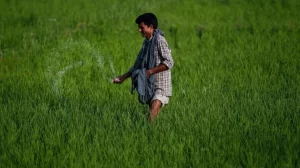Routing the subsidy through manufacturers and keeping the selling price of fertilisers artificially low, makes diversion of subsidised fertilisers profitable for dubious players

The availability of fertilisers at an ‘artificially’ low price is very tempting to all stakeholders in the supply chain. (File image)
About 41 percent of fertiliser subsidy is diverted to non-agricultural uses including smuggling to neighbouring countries, 24 percent is consumed by larger farmers and another 24 percent is spent on inefficient producers, the Economic Survey 2015-16 noted. That essentially means that just about 11 percent of the subsidy goes to small and medium farmers. The Union government subsidises fertiliser sales to keep input costs low for farmers. Diversion to purposes other than farming is a misuse of subsidy. Curbing it will save tens of thousands of crores of rupees spent on the subsidy.
The availability of fertilisers at an ‘artificially’ low price is very tempting to all stakeholders in the supply chain – manufacturers, distributors, retailers, etc – who can make a quick buck by selling it at much higher market-related prices in non-agriculture markets. The Union government attempted several administrative interventions to prevent such sales. These included neem coating, Aadhaar-authenticated invoices and a cap on the number of bags per transaction. Have these measures delivered?
Neem-coating: In 2015, the Centre directed all manufacturers and importers to do neem-coating of the urea supplies. The underlying premise was that this would render urea unusable for industrial purposes and hence, diversion would be curbed. But coating would work only if it is done. There lies the rub. It is almost impossible to police a humongous 777 million bags of 45 kg each (annual urea sale is 35 million tonnes) across the length and breadth of the country.
Clearly, neem coating hasn’t worked. Had it, we would have seen a substantial reduction in urea import. During 2021-22, India imported around 10 million tonnes of urea.
Aadhaar authenticated invoice: In March 2018, the government implemented a decision requiring retailers to generate an Aadhaar authenticated invoice and sale being registered on a point-of-sale (PoS) machine. The manufacturers were to get the subsidy only on submission of this electronic proof of sale. Prior to this, they were getting 95 percent of the subsidy ‘on receipt of material at a district’s railhead point or approved godown’ in case of urea (85 percent for non-urea fertilisers) and the balance five percent on confirmation of sales to farmers by states (15 percent for non-urea fertilisers). That system was prone to wholesale diversion of fertilisers straight from the railhead/godown.
The shift to the new dispensation from March 2018 also offered no guarantee against diversion, as the purchaser was only required to certify her identity by giving an Aadhaar number; she doesn’t have to give proof of her being a farmer. That meant even non-farmers could buy the subsidised fertiliser and sell it at a much higher price and profit from it.
Cap on bags per transaction: In August 2020, the Centre restricted purchase of urea to 100 bags per transaction, down from 999 bags. It also wanted states to cap the number of such transactions by a purchaser in a month. Additionally, it asked 22 major fertiliser-consuming states to identify the top 20 urea purchasers in each of their districts and monitor them.
Already, the Department of Fertilisers (DoF) prepares an agreed supply plan to cover all urea requirements (besides non-urea fertilisers) from domestic production and import. The states, in turn, allocate all of the urea arrivals and track disbursal up to the district level. Furthermore, the Centre has put in place a mobile fertiliser management system (mFMS) that keeps track of product inflows, outflows, stocks, etc at all levels in the supply chain. Despite these arrangements tracking every grain of fertilisers, if diversion has continued unabated, one wonders whether more controls (August 2020 order) made things any better.
Caps per season: The government now wants to cap the number of bags of subsidised fertilisers that a farmer can buy for the whole season. This cap is to be calculated based on the nutrient requirement linked to land holding, crops grown, etc. For buying in excess of the cap, she has to pay the non-subsidised/cost-based price. This calls for a monumental exercise involving data of around 140 million farm households, determination of bag requirement by each, feeding that information into the PoS machine and recording purchases on a real-time basis. The system is then required to raise the red flag when the cap is reached.
Even if all this is done successfully (doubtful), there won’t be any takers for the high cost/non-subsidised fertilisers. The idea isn’t workable.
To conclude, the government has only looked for administrative solutions to a problem that is policy related. This has to do with routing the subsidy through manufacturers and keeping the selling price of fertilisers ‘artificially’ low. That makes diversion so tempting that dubious players won’t mind breaking the rules and bureaucrats are more than willing to help them under quid pro quo.
The government should free up fertiliser pricing, dismantle all controls and give the subsidy directly to farmers. When low-priced fertiliser is not available in the market, the menace of diversion will automatically disappear.
UTTAM GUPTA is a policy analyst. Views are personal and do not represent the stand of this publication.
https://www.moneycontrol.com/news/opinion/administrative-measures-cant-curb-misuse-of-fertiliser-subsidies-10278901.html